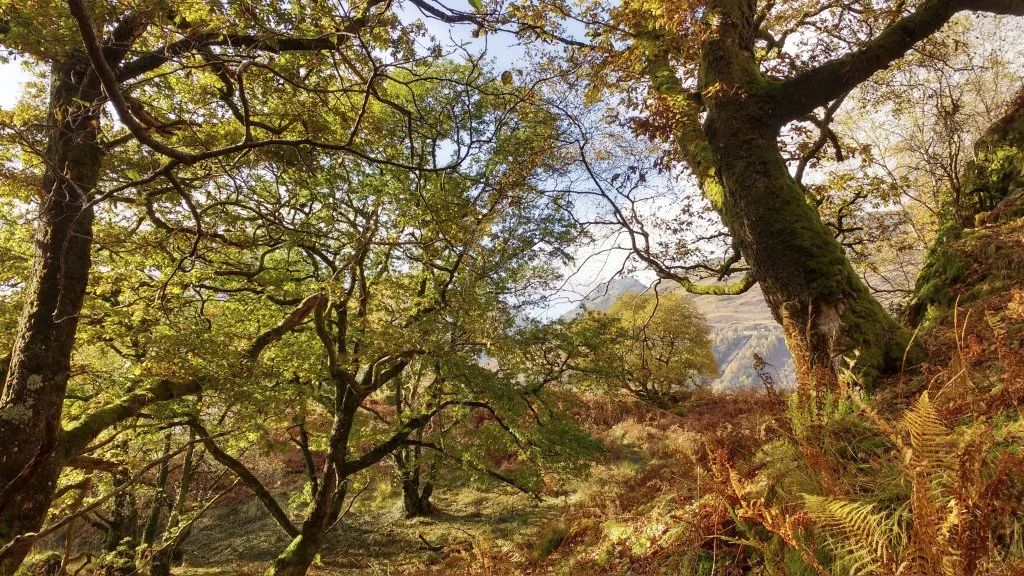The magical wood warbler
Because of their rich biodiversity, Scotland’s rainforests are great places to see birds. Dozens of species make their homes here, feasting on the annual bounties of invertebrates, seeds and berries. But these woodlands are particularly important for several species of migrant birds, which undertake an incredible journey from Africa to raise their families here each summer.
One of these is the wood warbler. These are small birds that, at first glance, look similar to the chiffchaffs and willow warblers that can be seen (and heard!) quite widely in parks and gardens across the UK. But wood warblers are a brighter yellow/green colour and have a white belly. They can also be hard to see, as they’re quite well camouflaged amongst the verdant green of the trees they hunt in. So one of the easiest ways to identify them, and particularly to tell them apart from other warblers, is to listen out for their song.
A mystical song from another world
Chiffchaffs sing their name loudly and often, particularly in the early spring. Willow warblers sing a long descending sequence of notes, sounding a little bit like a chaffinch, but higher and squeakier. The wood warbler song is very, very different (listen above).
Often referred to as a ‘spinning coin’, it may start with a ‘pee pee pee pee’ call and then move on to a ‘pip pip pip pip’ that suddenly gets faster and faster, before racing away at high speed, as though the wood warbler was performing an impressive roll on the world’s tiniest snare drum!
There’s actually something a bit otherworldly about it. Birdsong is normally soothing and relaxing, or sometimes a bit melancholy. But the wood warbler’s song is strange and magical, and makes any woodland feel like its harbouring fairies and sprites behind every tree. The even seem to sing ahead of you and then behind you, giving you that spooky feeling of being watched! Indeed, the song is often added to the background soundtrack of TV programmes if the characters find themselves in a particularly mystical bit of woodland, something to listen out for…
A species struggling for survival
Another way of identifying wood warblers is by location. They’re not widespread within the UK, and their preferred habitat is western woodland, particularly oak woods within the temperate rainforest zone in Wales and Scotland.
Sadly, they’re also becoming quite rare, so your chances of seeing one are getting smaller. Numbers have been plummeting since the 1990s, and they’re now Red Listed as a bird of conservation concern.
The reasons for these big declines are unclear, but similar population drops have been seen in other migrant species. In the case of the wood warbler, it may well be a combination of factors, like climate change, and the loss of the oak woods where they prefer to raise their families. Even small changes in things like the understory of woodland, or a decline in particular insect numbers could be making a difference.
It really highlights the importance of protecting our remaining areas of rainforest, to ensure that struggling birds, like the wood warbler, have the very best chance of survival.
Where to see (or hear) a wood warbler
If you’d like to have an encounter with a wood warbler in Scotland, your best bet is to have a wander through an oak wood within the temperate rainforest zone. They’re becoming a little quieter in June as they settle down to breed, but you might still be able to catch a glimpse of one flitting around in the branches high overhead.
And if you are lucky enough to hear a wood warbler sing when you’re out on your walk, then shut your eyes just for a moment or two, and allow yourself to be transported into their magical world.
Top wood warbler locations
RSPB Scotland Inversnaid www.rspb.org.uk/reserves-and-events/reserves-a-z/inversnaid/
Taynish National Nature Reserve www.nature.scot/enjoying-outdoors/scotlands-national-nature-reserves/taynish-national-nature-reserve
WTS Dunollie Wood www.woodlandtrust.org.uk/visiting-woods/woods/dunollie-wood/
SWT Rahoy Hills scottishwildlifetrust.org.uk/reserve/rahoy-hills/
NTS Balmacara Estate www.nts.org.uk/visit/places/balmacara-estate
Warbler ID
Chiffchaffs (left) and willow warblers are much more common than wood warblers. You may also see these species in the rainforest, and they can be tricky to tell apart unless you get a good look! Pic - John Bridges.




